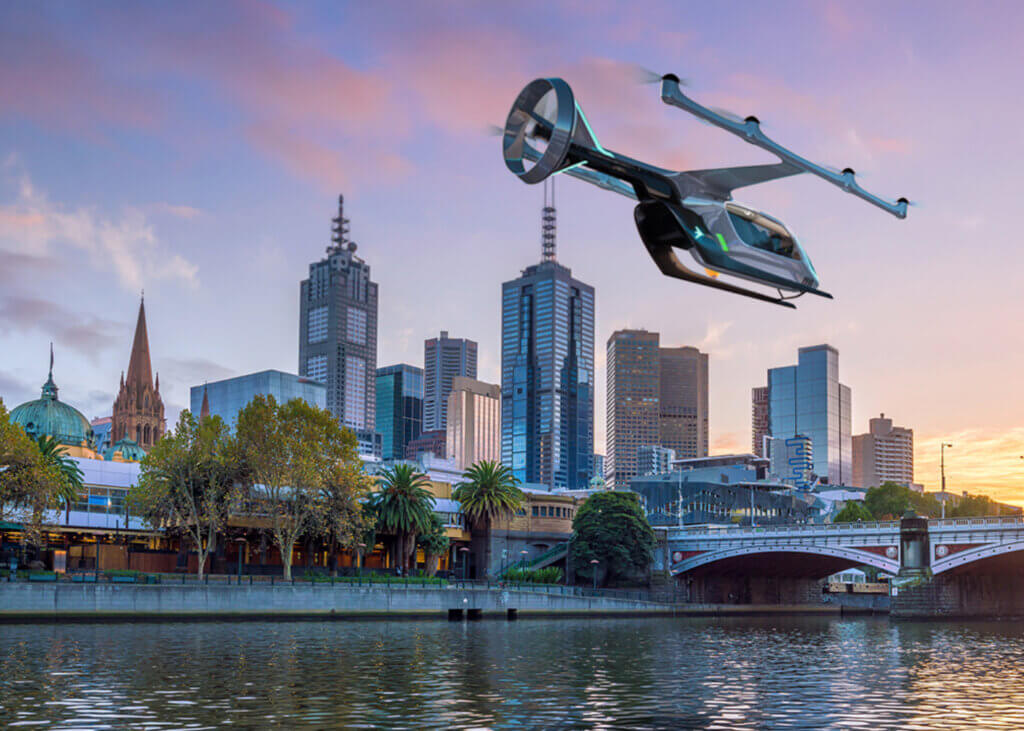Australian advanced air mobility (AAM) stakeholders expect to see the first commercial services in the country in 2027 — but there’s still a lot that needs to be done to make this possible, delegates heard at this week’s AAM Summit, organized by the Australian Association for Uncrewed Systems (AAUS).

To help the sector get there, the AAUS plans to launch a vision statement for AAM in Australia by November, followed by a roadmap that will deliver clear, actionable, prioritized guidance for industry, government and stakeholders, said Reece Clothier, senior manager of global regulatory strategy at Boeing and AAUS president.
Consultations with stakeholders conducted by AAUS and L.E.K. Consulting as part of the vision and roadmap process have highlighted that Australia has a lot to gain from AAM, providing the opportunity to overcome the country’s tyranny of distance and enhancing the connectivity of communities.
“The distribution of our population means that we have a disproportionate infrastructure and services spend trying to connect our population,” said Clothier, pointing to more than A$33 billion (US$21 billion) spent each year on road-related infrastructure.
AAM could reduce this burden, revolutionizing urban and regional transport, and providing reduced travel times and improved mobility options, he said.
Australia is an attractive environment for AAM, stakeholders believe, with significant under-utilized airspace, much of which is near or over water. This would be ideal for early AAM activity to help build social license. The country also has a “mature, trusted and risk-based regulatory environment,” Clothier said.
Realizing AAM in Australia could provide environmental, economic and social benefits, including creating job, attracting foreign investment, supporting noise and emissions reduction, and providing new export opportunities, stakeholders also agree AAM could deliver safety benefits over other forms of transport and improve public services.
Early AAM operations
Industry stakeholders expect Australia’s AAM to start in 2027 in small numbers, growing cautiously before a sustainable and significant industry scale is reached.
“There are some differences in opinion about timing and how fast we’ll get there, but there is general consensus about the phases of this scale-up,” said Natasha Santha, partner at L.E.K. Consulting’s transport, new mobility and energy practice.
An initial “do no harm” phase will focus on proving the value and showing no harm in order to build social license. This is when services are expected to be at a higher cost, piloted, and operated in low-impact, low-risk locations.
“It’s about proving success, showing benefit, creating interest among the community,” Santha said.
There is some variation in views on what use cases will emerge in Australia first, with some stakeholders prioritizing passenger transport, starting with experiential and tourism applications, and others following a social need path, such as aeromedical and emergency response.
“Regardless of the strategy, there was broad recognition that building social license should be the first collective goal,” Santha said, adding that reaching the next phase will depend on social acceptance, customer willingness to use the service, and airspace integration in higher risk locations.
In this phase, consumer interest and demand will grow, aspects of automation will be introduced, vertiports will become intermodal hubs and cost of service will reduce, stakeholders believe.
Ultimately, the end goal is to see “AAM across all parts of urban and regional communities. Remote piloted operations will become more commonplace, and services affordable and highly accessible,” Santha said.
To reach commercialization, stakeholders recognize “there’s a lot that needs to be done,” Santha said. A number of key enablers, including regulatory paths for aircraft certification, training, maintenance and infrastructure, as well as access to airspace, the radio frequency spectrum and the necessary financial and human capital, are required to make it a reality, Santha said.
Whole-of-government approach
Delegates heard that the federal government is taking a whole-of-government approach to enable AAM.
“Our goal is to ensure we have the right policies in place, the appropriate regulation and all the necessary enabling infrastructure to support and enable the industry,” said Richard Wood, first assistant secretary for international aviation, technology and services at the Department of Infrastructure, Transport, Regional Development, Communications and the Arts. “Australia is in a unique position to be a leader in the development of AAM worldwide, with a robust and flexible aviation ecosystem and regulatory regime.”
The country’s geography also presents opportunities, he said, pointing to the variety of urban and regional environments allowing for the experimentation and refinement of aircraft and service models.
The government’s AAM Consultative Committee is supporting the development of AAM policy. A draft AAM strategy is currently being developed with publication expected to align with the country’s new Aviation White Paper in mid-2024. The strategy will outline the benefits AAM can bring to Australia, identify government action to enable industry development, set out a timeline for action and clarify roles and responsibilities. There is drive at all government levels to make AAM a reality, according to Wood.
While the federal government’s progress and support for AAM is positive, the state and local government focus is less so, said Rob Weaver, Embraer’s urban ATM global business development lead, highlighting it as his greatest concern.
Clem Newton-Brown, CEO of Skyportz, agrees. “Local and state governments need to step it up if they want to be part of it,” he said, adding that they need to be working on new planning rules for vertiports and eliminating red tape.
Local activity
Some state and local governments have embraced AAM. At the summit, the Victorian State Government launched its new AAM action plan for creating commercialization pathways. While Victoria has previously been criticized for failing to capitalize on its opportunity to be a global AAM first mover (with Melbourne selected by then Uber Air back in 2019 as one of three pilot cities, along with Dallas and Los Angeles), it is now working to realize the potential.
Victoria expects next year to publish initial guidance material to support the assessment of early vertiport applications; explore research opportunities to quantify AAM and electric aviation market opportunities; and determine skills and capability required to support AAM. From 2025, it plans to review and update land use and development regulation to support vertiport planning infrastructure and seek to embed AAM in future transport, precinct development and freight policy.
Victoria’s Latrobe City Council is showing what is possible at the local government level. The council has identified AAM as an opportunity to diversify its economy, which is facing the closure of local power stations that have long formed the basis of the region’s gross domestic product.
Bruce Connolly, senior manager of investment and transition at the Latrobe City Council, said the council is working with local universities, the state’s investment arm Invest Victoria, and technology companies on AAM test and evaluation activities, establishing the Latrobe Aerospace Technology Precinct at Latrobe Regional Airport.
One project is the regional air mobility surrogate trials (RAST) involving Textron Systems Australia, Swinburne University of Technology’s Aerostructures Innovation Research Hub (AIRHub) and Invest Victoria. RAST will see a series of unmanned drone flights conducted from the airport and around Latrobe City next February to assess how future AAM platforms operating tourism, aeromedical and logistics flights can be integrated. The project also focuses on community engagement, with engagement workshops already underway.
To help drive development and capture investment going into AAM elsewhere, Swinburne’s AIRHub and industry partners have launched a bid to establish a new cooperative research center (CRC) for AAM. Australia’s CRC program is a federal government initiative that funds industry-led collaborations between industry, researchers and end users over a 10-year period.
“CRCs are about building a new industry,” said Adriano Di Pietro, AIRHub director.
The competitive bid process for new CRCs starts in December and closes in March, leading to stage two in December 2024 and the new CRCs operating from July 2025. The fledgling AAM CRC has started discussions with interested partners.
“Let’s work as an industry to make this happen,” said Di Pietro, who believes a CRC could play a significant role in the realization of AAM in Australia.









